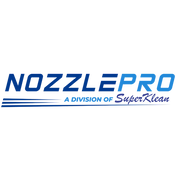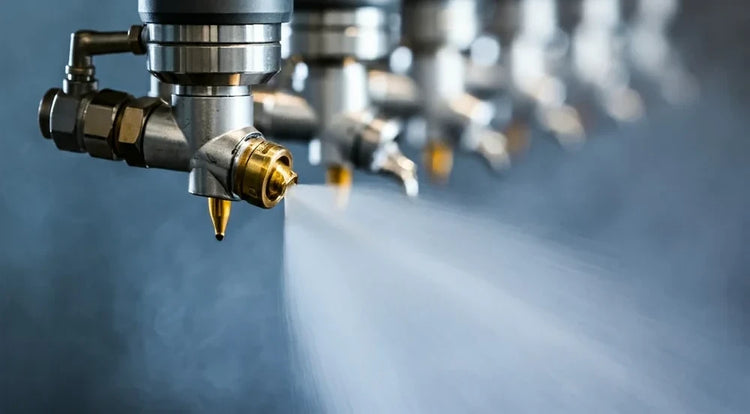Ore Washing & Slurry System Spray Nozzles
High-Performance Nozzles for Screens, Trommels, Slurry Conditioning & Extreme Abrasion Environments
Efficient ore washing removes clays and fines, improves downstream processing, and maximizes mineral recovery. NozzlePro supplies high-impact, mining-ready spray nozzles engineered for harsh duty—delivering cleaner feedstock, consistent plant performance, and dramatically reduced operational costs.
Ore washing is a critical balancing act: enough impact to break up clay and fines without over-watering screens, trommels, or downstream circuits. We pair the correct spray pattern, angle, and standoff with abrasion-resistant materials to keep throughput high and maintenance low.
For operations processing abrasive slurries, standard nozzles fail within weeks. Our ceramic orifice, hardened stainless steel, and tungsten carbide solutions extend service life to months or years—transforming your Total Cost of Ownership through dramatically reduced downtime and maintenance frequency.
Applications in Ore Washing & Slurry Systems
From primary crushing to final dewatering, NozzlePro slurry solutions optimize every stage of ore processing:
🪨 Crushed Ore Cleaning
High-impact sprays dislodge clay balls and fines from crushed ore to improve feed quality and protect downstream separation stages. Critical for recovery optimization.
Flat Fan Options →🛞 Screen & Trommel Washing
Precision bars prevent screen blinding and trommel clogging. Size angle/spacing for full coverage at your deck width and open area. Performance-critical application.
Full Cone Bars →🌊 Slurry Conditioning
Uniform distribution promotes efficient separation in flotation and refining—wetting fines without diluting the circuit. Maximizes mineral recovery rates.
Hollow Cone Fogging →🔄 Log Washers & Scrubbers
Continuous spray on rotating equipment requires extreme durability. Slurry-rated nozzles withstand hours-long operation without failure. Hardened SS316L ideal.
High-Pressure Options →💧 Recirculation Systems
Filtered but still abrasive recirculated water challenges standard nozzles. Clog-free design handles sediment in return water. Extends wash water life with mineral recovery.
Recirculation Solutions →🏭 Hydrocyclone Discharge
Spray wash after hydrocyclone for fine-particle recovery. High-pressure, abrasive environment demands ceramic or tungsten carbide. ROI achieved in 6-12 months.
Tungsten Carbide →Material Selection: The Science Behind Superior Performance
Choosing the right nozzle material dramatically impacts service life and total cost of ownership. Understanding the strengths and limitations of each material category is critical for optimizing your slurry system performance.
Material Performance Comparison
| Material | Service Life | Cost | Hardness | Best For |
|---|---|---|---|---|
| Ceramic Orifice | 12-24 months | $800-1,500 | 2000+ HV | Maximum abrasion resistance; extreme slurry concentrations (30%+ solids) |
| Hardened SS 316L | 6-12 months | $400-800 | 450-550 HV | Excellent balance of durability and cost; most slurry applications |
| Tungsten Carbide | 12-18 months | $1,000-2,000 | 1400-1600 HV | Ultra-extreme abrasion; specialized mining and quarrying applications |
| Standard SS 316 | 2-6 months | $200-400 | 200-300 HV | Low abrasion or light-duty applications (not recommended for slurry) |
| Advanced Polymer | 3-8 months | $150-300 | 150-250 HV | Budget-constrained operations; moderate slurry concentration |
Detailed Material Specifications
🏆 Ceramic Orifice Nozzles
Material: Alumina or silicon carbide ceramic insert in hardened stainless steel body.
- Hardness: Extreme (2000+ HV); resists abrasion from all mineral compositions
- Service Life: 12-24 months in extreme slurry concentrations
- Best For: High-concentration slurries (30%+ solids), severe abrasion scenarios
- ROI: Highest upfront cost; lowest maintenance frequency = 40-60% TCO reduction vs standard
- Limitation: Brittle if over-pressurized; requires careful handling
⚡ Hardened Stainless Steel 316L
Material: High-carbon, nitrogen-enhanced 316L stainless with hardness optimization.
- Hardness: 450-550 HV; excellent wear resistance with toughness
- Service Life: 6-12 months in moderate-to-high slurry concentrations
- Best For: Most industrial slurry operations (the "goldilocks" solution)
- ROI: Best balance of durability, cost, and TCO across diverse applications
- Advantage: Tolerates over-pressure; handles flow surge better than ceramic
💎 Tungsten Carbide
Material: Tungsten carbide particles in cobalt binder; extreme hardness.
- Hardness: 1400-1600 HV; second only to diamond
- Service Life: 12-18 months in extreme slurry with sand/rock content
- Best For: Ultra-aggressive applications; specialized mining and quarrying
- Cost Consideration: Premium pricing ($1,000+); justified in extreme conditions
- Advantage: Superior to ceramic for certain mineral types (silica-based)
🔧 Standard Stainless Steel 316
Material: Traditional 316 stainless without hardening treatment.
- Hardness: 200-300 HV; standard corrosion resistance
- Service Life: 2-6 months in abrasive slurry (not recommended)
- Cost: Lowest upfront ($200-400); highest replacement frequency
- Use Case: Only in light-duty or low-abrasion applications
- TCO Reality: False economy; 5-6× replacement frequency negates savings
♻️ Advanced Polymer
Material: High-performance engineering plastics with abrasion additives.
- Hardness: 150-250 HV; soft but wear-resistant with lubricity
- Service Life: 3-8 months in moderate slurry concentrations
- Advantage: Very low cost; easier on equipment if misapplied
- Limitation: Cannot handle high pressure or hot slurries
- Best Use: Temporary installations or budget-constrained operations
TCO Reality Check: The 3-Year Payoff
A mining operation running 3 washing lines × 8 nozzles = 24 nozzles. Standard SS316: 24 × $250 = $6,000 initial cost, replaced every 2 months ($18,000/year). Hardened SS316L: 24 × $600 = $14,400 initial, replaced annually ($14,400/year). Year 1 savings: $3,600. By year 3, cumulative savings exceed $10,000. Upgrade to ceramic and savings double. This is why smart operators invest in durability upfront.
Recommended Spray Patterns & Technical Specifications
Performance characteristics optimized for abrasive slurry environments:
💧 Flat Fan (High Impact)
Linear coverage with strong impingement—ideal for scalping decks and chute wash bars. Choose tighter angles for concentrated energy on stubborn clays.
Explore Flat Fan →🔷 Full Cone (Uniform)
Even circular distribution for general ore washing where broad coverage prevents re-agglomeration and maintains consistent density in wash circuits.
Explore Full Cone →🌀 Hollow Cone (Precision Fog)
Ring spray pattern for slurry conditioning and light coverage applications. Creates consistent droplet size for finesse work in sensitive circuits.
Explore Hollow Cone →Technical Specifications & Operating Parameters
| Application | Pattern | Pressure | Flow / Nozzle | Material | Collection |
|---|---|---|---|---|---|
| Scalping / Primary Screen | Flat Fan | 30–60 PSI | 1–4 GPM | Hardened SS 316L | Flat Fan |
| Trommel Interior Bars | Full Cone | 20–50 PSI | 2–5 GPM | Hardened SS 316L | Full Cone |
| Chute/Transfer Wash | Flat Fan / Full Cone | 25–50 PSI | 1–3 GPM | Hardened SS 316L | Flat Fan |
| Slurry Conditioning | Hollow Cone | 20–40 PSI | 0.5–2 GPM | Standard SS 316 | Hollow Cone |
| Hydrocyclone Discharge | Flat Fan / Solid Stream | 50–100 PSI | 2–8 GPM | Ceramic / Tungsten Carbide | Tungsten Carbide |
| High-Wear Zones | Flat Fan / Solid Stream | 40–80 PSI | Per sizing | Ceramic / Tungsten Carbide | Premium Materials |
How We Size Ore Wash Bars & Slurry Systems
Proper nozzle sizing is critical to performance and cost optimization:
Coverage & Impact Methodology
- Angle & Standoff: Match spray angle to bar spacing for ~100–120% overlap at the deck plane.
- Flow & Pressure: Start with 20–60 PSI; raise pressure for stubborn clay, not just flow.
- Nozzle Count: Width ÷ (effective pattern at deck) → number of tips per row; then stack rows by burden depth.
- Materials: 316/316L for corrosion; tungsten carbide where fines are highly abrasive.
- Straining: Use adequate filtration (100-150 micron) to protect small orifices in multi-row bars.
- Recirculation: For filtered recirculated water, specify clog-resistant designs or larger orifices.
Step-by-Step Selection Guide
- Characterize Your Slurry: Identify solid concentration (% by weight), particle size distribution, and mineral composition. Sand/silica? Hard rock? Iron ore? Material type affects wear rate dramatically.
- Assess Current Performance: How long do existing nozzles last? 2 weeks? Monthly? This baseline determines upgrade strategy and ROI timeline.
- Calculate Downtime Cost: What is the cost of 1 hour production downtime? 10 nozzle replacements per year × 2 hours each × your hourly cost = true operational cost of failures.
- Select Material Based on Use: Ceramic for highest durability if downtime cost justifies premium; hardened SS316L for best balance; standard SS only for low-concentration applications.
- Specify Spray Pattern: Full cone for uniform washing; flat fan for impact cleaning; hollow cone for light coverage.
- Consider Recirculation: Filtered recirculated water still carries fines—nozzles must tolerate partial clogging risk. Specify clog-resistant designs or larger orifices.
- Factor Maintenance Access: Can operators replace nozzles quickly? Position nozzles for easy removal or specify quick-disconnect headers to reduce labor costs.
ROI Calculator: Reduce Downtime & Maintenance Costs
Understand exactly how much you can save by upgrading to slurry-rated nozzles. Enter your current metrics and see the financial impact:
💰 Total Cost of Ownership Calculator
Current Annual Cost: $0
Upgrade Annual Cost: $0
Annual Savings: $0
3-Year Cumulative Savings: $0
Break-Even Timeline: 0 months
TCO Benefits of Premium Slurry Nozzles
Dramatically Extended Service Life – Ceramic 12-24 months vs standard 2-4 weeks = 60-90% fewer replacements annually
Reduced Operational Downtime – Fewer replacement cycles = less equipment downtime = higher throughput and revenue
Clog-Free Performance – Premium materials + optimized orifice design handle recirculated water without blockages
Superior Material Recovery – Consistent spray performance maximizes fines capture in recirculation systems
Lower Total Cost of Ownership – Premium upfront cost amortized over 12+ months service life = 40-60% cost reduction
Predictable Maintenance Costs – Scheduled replacements vs emergency failures = better budget planning and supply chain management
Improved Safety – Automated cleaning systems reduce worker exposure to confined spaces and slurry hazards
Environmental Compliance – Efficient water usage and reduced chemical need supports sustainability goals
Complete Your Mining Slurry System
Complementary NozzlePro solutions for ore processing and slurry management:
⛏️ All Mining Solutions
Complete range of spray nozzles optimized for mining ore washing, dust suppression, cooling, and conveyor maintenance systems.
Explore All Mining →🪨 Flat Fan Nozzles
High-impact cleaning on screens and surfaces. Essential for scalping and trommel washing. Hardened SS 316L for durability.
Browse Flat Fan →🔷 Full Cone Nozzles
Slurry-rated full cone for uniform coverage washing. Perfect for general ore conditioning and settling applications.
Explore Full Cone →🌀 Hollow Cone Nozzles
Ring spray pattern for slurry conditioning and light coverage. Ideal for precision flotation feed preparation.
View Hollow Cone →💎 Tungsten Carbide Nozzles
Ultra-extreme durability for severe abrasion zones. Extended service life (12-18 months) justifies premium pricing.
See Tungsten Carbide →⚡ High-Pressure Nozzles
For aggressive slurry washing and descaling. 40-100 PSI performance in extreme conditions.
View High-Pressure →Frequently Asked Questions About Ore Washing & Slurry Nozzles
Why do standard nozzles fail so quickly in slurry applications?
What's the difference between ceramic and tungsten carbide?
What's the best nozzle setup for crusher and transfer-point dust?
How do I prevent clogging in recirculated wash water?
Is hardened SS316L better than ceramic for my application?
What pressure should I run slurry nozzles at?
How do I calculate ROI on upgrading from standard to premium nozzles?
What are the differences between ore washing and general slurry conditioning?
Transform Your Ore Washing Economics
NozzlePro slurry nozzles dramatically reduce downtime and maintenance costs through superior durability. Ceramic orifice, hardened stainless steel, and tungsten carbide options engineered for mining and aggregate operations. Calculate your ROI above, then contact our slurry specialists to design your optimized system.

